£11.99
Rome and Attila: Rome’s Greatest Enemy (The Fall of the Roman Empire)
In the first major work written about Attila in decades, Nick Holmes rewrites the story of Attila and Rome. Contrary to his brutal legend, Attila was a complex and captivating personality. A great warlord who despised ostentation, admired bravery and valued loyalty.
He led his steppe nomads further west than Genghis Khan or Tamerlane. He nearly destroyed the Roman Empire. But his vast ambition undid him. This book is a must read for those interested in Rome, the Huns and military history.
This is the third volume in Nick Holmes’ series on The Fall of the Roman Empire. The first volume,
The Roman Revolution, covers the little known ‘crisis of the third century’ when barbarian invasions nearly destroyed classical Rome and led to a revolution in Roman government, the army and religion, including the extraordinary growth of Christianity. The second volume, The Fall of Rome, covers the barbarian invasions of the western half of the empire, culminating in the sack of Rome itself by the Goths in AD 410. Further volumes will continue Rome’s turbulent history, from its revival under the emperor Justinian to the rise of Islam, the beginnings of Byzantium and the dawn of the Middle Ages.| Dimensions | 12.85 × 2.41 × 19.84 cm |
|---|---|
| Publisher | Puttenham Press (29 Jan. 2024) |
| Language | English |
| Paperback | 376 pages |
| ISBN-10 | 1739786548 |
| ISBN-13 | 978-1739786540 |
| Dimensions | 12.85 x 2.41 x 19.84 cm |
8 reviews for Rome and Attila: Rome’s Greatest Enemy (The Fall of the Roman Empire)
Related products
Persians: The Age of The Great Kings
£7.49THE PERSIANS is a definitive new history of the Persian Empire, the world’s first superpower.
The Great Kings of Persia ruled over the largest Empire of antiquity, stretching from Libya to the Steppes of Asia, and from Ethiopia to Pakistan. At the heart of the Empire was the fabled palace-city of Persepolis where the Achaemenid monarchs held court in unparalleled grandeur. From here, Cyrus the Great, Darius, Xerxes, and their heirs passed laws, raised armies, and governed their multicultural Empire of enormous diversity.
The Achaemenids, however, were one of the great dysfunctional families of history. Brothers fought brothers for power, wives and concubines plotted to promote their sons to the throne, and eunuchs and courtiers vied for influence and prestige.
Our understanding of the Persian Empire has traditionally come from the histories of Greek writers such as Herodotus – and as such, over many centuries, our perspective has been skewed by ancient political and cultural agendas. Professor Llewellyn-Jones, however, calls upon original Achaemenid sources, including inscriptions, art, and recent archaeological discoveries in Iran, to create an authentic ‘Persian Version’ of this remarkable first great empire of antiquity – the Age of the Great Kings.
Cosmic Legacy of Ancient Egypt
£15.49Today, we do not use our ancient cosmic orientation to relate to the natural world as we once did. It’s no longer determined by where we are or what time it is by the Sun’s daily motion across the sky. Our perception of the outside world has changed, and we have lost our sense of wholeness within a great system. Factors such as our work and play rhythms, clothing, diet, and travel are affected by climatic and seasonal factors. These factors affect our unconscious sense of timing and our ability to communicate with nature, which we often overlook.
Often we marvel at the apparent serenity and spiritual confidence of ancient people, forgetting that their tools were taught and used within an environment that encouraged them to recognize and embrace natural and divine forces. These tools enabled one to maintain a profound sense of cosmic orientation, keep it, and view one’s role as actual spiritual work. In ancient Egypt, a man named Al was gifted with a sense of cosmic orientation.
As dams have been constructed in our era, the Nile no longer produces an annual flood, but understanding the rhythm of that event and others associated with it is essential to understanding Egyptian rituals and ceremonies. To restore cosmic orientation, we need to leave our temporal field of time and enter the visible universe of ancient Egypt, where cosmic rhythms sustained human life, nature, and even the gods.
For Egyptians, both secular and spiritual matters were governed by the concept of time. Even though the gods’ realms (Neheh) were considered eternal, they were also continuous and manifested in cycles. According to cosmic life’s ebbs and flows, gods appeared at different times but were lasting and constant. Through the medium of heavenly bodies, events take place in linear time (Djet) and according to the ebb and flow of cosmic life. The three dimensions of cosmic activity were thought to be formed by three distinct rhythms, the lunar, solar, and stellar.
Aspects of Roman History 31 BC-AD 117 (Aspects of Classical Civilization)
£34.77This new edition of Aspects of Roman History 31 BC- AD 117 provides an easily accessible guide to the history of the early Roman Empire. Taking the reader through the major political events of the crucial first 150 years of Roman imperial history, from the Empire’s foundation under Augustus to the height of its power under Trajan, the book examines the emperors and key events that shaped Rome’s institutions and political form. Blending social and economic history with political history, Richard Alston’s revised edition leads students through important issues, introducing sources, exploring techniques by which those sources might be read, and encouraging students to develop their historical judgement.
The book includes:
- chapters on each of the emperors in this period, exploring the successes and failures of each reign, and how these shaped the empire,
- sections on social and economic history, including the core issues of slavery, social mobility, economic development and change, gender relations, the rise of new religions, and cultural change in the Empire,
- an expanded timeframe, providing more information on the foundation of the imperial system under Augustus and the issues relating to Augustan Rome,
- a glossary and further reading section, broken down by chapter.
This expanded and revised edition of Aspects of Roman History, covering an additional 45 years of history from Actium to the death of Augustus, provides an invaluable introduction to Roman Imperial history, surveying the way in which the Roman Empire changed the world and offering critical perspectives on how we might understand that transformation. It is an important resource for any student of this crucial and formative period in Roman history.
The Aztec Empire: An Enthralling Overview of the History of the Aztecs, Starting with the Settlement in the Valley of Mexico (Ancient Mexico)
£11.71The remarkable Aztecs formed a vast, organized empire renown for military prowess, expansive trade, intriguing culture, and ingenious agriculture – all from an
island in a swamp. But where was their mysterious homeland of Aztlan? How did they ascend to dominance in the Valley of Mexico?Explore the mesmerizing origins of the Aztecs, discover how a wandering desert tribe came to rule much of present-day Mexico, and investigate the spectacular – albeit somewhat depraved – culture that set their civilization apart.
This easy-to-read, comprehensive, and engaging history of the Aztec Empire will unlock the little-known and awe-inspiring stories and culture of a legendary people. This well-researched and authoritative presentation, accompanied by striking illustrations, brings the Aztec civilization to life.
Here are some of the fascinating questions you will explore:
- What secrets have recent archaeological finds uncovered about the Aztecs and other Mesoamerican cultures?
- How did the startling cultures that existed before the Aztecs influence them? What made these pre-existing cultures famous?
- What prophesies propelled the Mexica into their empire-building destiny and formed their self-identity?
- Why did the Mexica build their astonishing city on an island in the middle of a lake? How did it grow into one of the largest cities in the world at that time?
- Was their mysterious homeland of Aztlan a real place? If so, where was it?
- What’s this story about an eagle on a cactus eating a rattlesnake?
- How did the Mexica turn the tables to rule over the tribes that once dominated them?
- What intrigue led to the coalition armies and the Triple Alliance?
- How did the Aztecs form their extensive network of power and organize their far-flung city-states?
- What were their mythology and religion like? Did they actually practice human sacrifice?
- How did they use their stunning sculptures and brilliant artwork as a type of propaganda?
- Were they really one of the first civilizations to require education for all classes and both boys and girls?
- What did they eat? Was it anything like present-day Mexican food?
- How did the common people live? What did they do for fun?
- What did the Aztecs do when the Spaniards landed in their territory?
- How did conquistador Hernán Cortés cunningly form alliances with the Aztecs’ enemies?
- And much, much more!
Scroll up and click the “add to cart” button to learn more about the incredible Aztecs!
Justinian’s Empire: Triumph and Tragedy (The Fall of the Roman Empire)
£12.99IT WAS AN AGE OF GLORY…
…BUT ALL THAT GLITTERS IS NOT GOLD.
‘A riveting account of Justinian’s reign that challenges traditional consensus’ Kirkus Reviews
The sixth-century AD witnessed a remarkable turn-around in the Roman Empire’s fortunes. Justinian’s general, Belisarius, recovered North Africa and Italy from the barbarians. An impressive new law code was inaugurated that would endure to this day. Astonishing building projects, like the iconic Hagia Sophia, rivalled the great monuments of Old Rome.
But rather than restoring Rome’s greatness did Justinian in fact pave the way for its collapse less than a century after his death? Drawing on the contemporary sources, especially those of the chronicler Procopius, Nick Holmes reveals a darker side to Justinian – a ruthless opportunist, whose costly conquests and misguided priorities drained the empire’s wealth and critically weakened its army.
This is the fourth volume in Nick Holmes’ series on the Fall of the Roman Empire. The first three books trace the empire’s story from the ‘crisis of the third century’, through its reinvention by Constantine as a Christian state, and then onto the fall of its western half. A fifth volume will tell of its rapid demise in the seventh century AD, when the first Islamic Caliphate became the new superpower of western Eurasia.
Praise for Nick Holmes’ Books
‘A talent for storytelling’ Kirkus Reviews
‘Clear, succinct and compelling’ AudioFile Magazine
‘Perhaps the best historical story-teller alive’ Amazon Reviewer

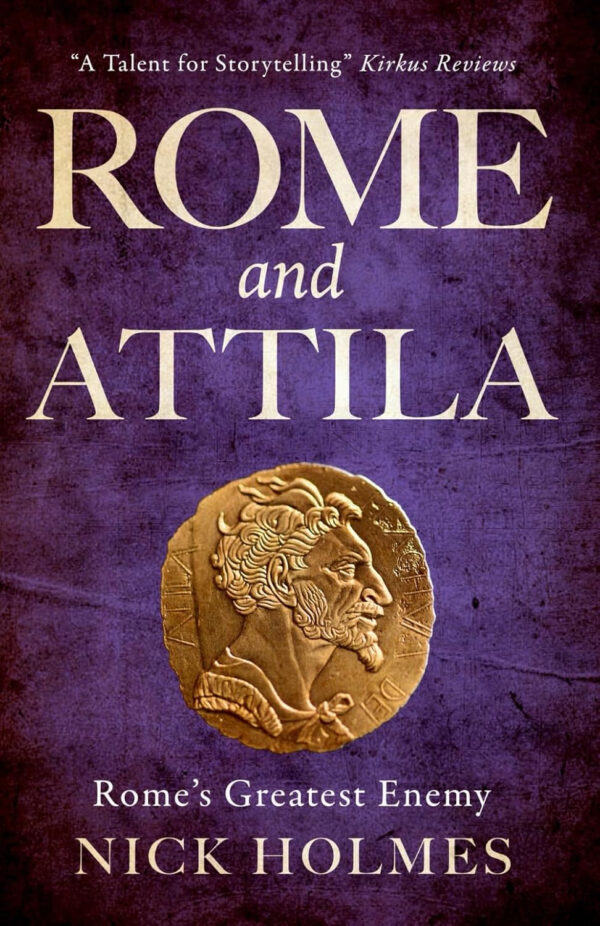


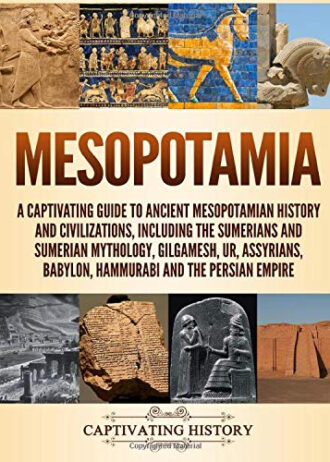
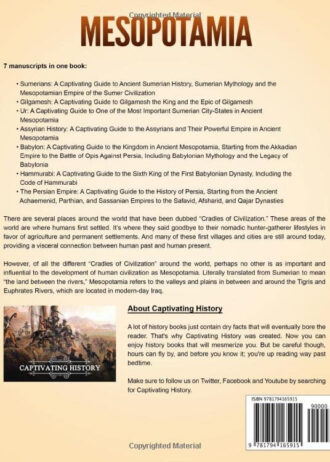
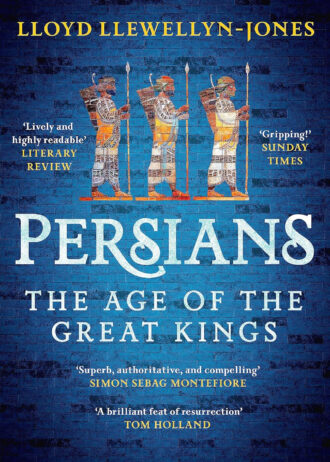


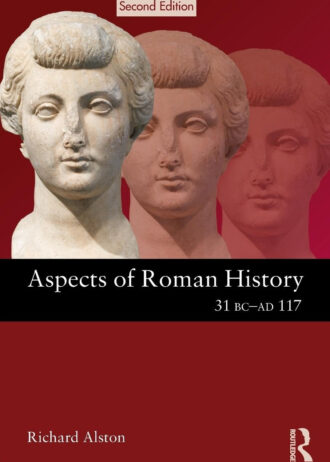
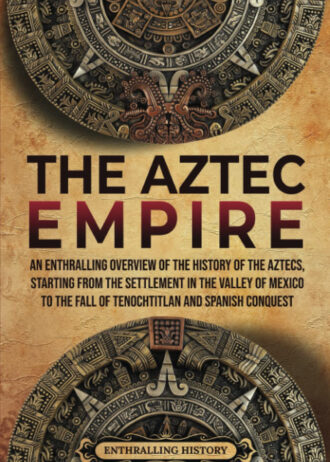
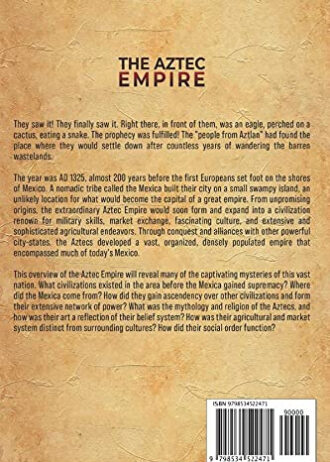
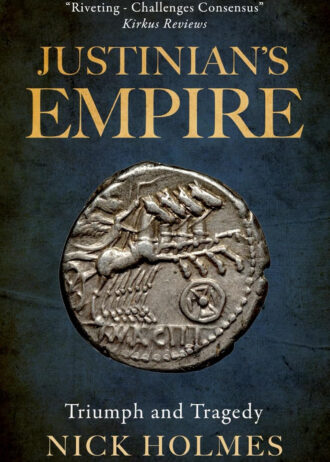
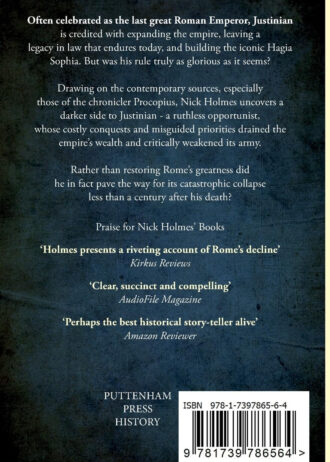
John S Whitaker –
I really enjoyed reading this book.
SCH –
Like the rest of this series, it is concise to the point have enjoyed the whole set
Mr B. –
No dislikes. Interesting and informative.
Kmc –
Holy good stuff
It was,well written ,easy to follow along, poignant, precise and concise. I wad wondering if the one emissary priscus was going to show up. And sure enough he did. .Y
Jacob S. –
Remarkable
Very Talented writer, just an Awsome series. I’m really looking forward to the next 3 books.If you’re a history buff like myself, you’ll love this series 🙂
Lori –
Interesting history
Good read on History
Brad –
A good read
The author has a style which makes the history of that period very interesting rather than dour. He sometimes also offers his theories on certain events which are very plausible. The historical journal from Priscus offers an idea of what Attila was like, and the chronology of emperors at the end of the book is a good summary.
Hamilcar Barca –
“He was just as scheming and back-stabbing as any good Roman.”
Rome and Attila, Book 3 in a projected 6-volume series, focuses on the short-but-critical historical time period 410-476 CE, although it also recaps the events of 360-410 CE, which were detailed in Book 2. I enjoyed meeting all sorts of movers and shakers in the decline of the Roman Empire. Attila receives the primary focus; almost 100 pages of the book are devoted to his life and impact. But a lot of other players also are introduced, including Ataulf, Valentinian III, Aetius, Theodoric, Ricimer, Marjorian, Alaric, Gaiseric, and Odoacer. A number of influential women are also spotlighted, including Galla Placidia, Hypatia, Honoria, Kreka, Aelia Pulcheria, and Aelia Eudocia. Galla Placidia is a particularly memorable. I was impressed with the way the author juggles the various military powers and their activities. You have Western Roman Emperors, Eastern Roman Emperors, Persians, Huns, White Huns, Visigoths, usurpers, Vandals, and all sorts of Germanic tribes, each carrying out their own agenda. Yet somehow it never became confusing. I also liked the way other influences are addressed cited in explaining the Rome’s collapse. Climate change caused the Huns to pull up stakes and move en masse eastward. The Huns used Germanic mercenaries to bolster their ranks, and therefore were dependent on Roman tribute to keep their position of dominance. The Persian Empire was beset by other Hunnic hordes, so they became keen on maintaining friendly relations with Constantinople, which spared the Eastern Empire the tribulations endured by Rome. The occasional “aside” sections were also great. When Rome fell, what happened to the legionnaires stationed in the hinterlands? Who were the Huns, where did they come from, and why did they disappear so quickly and thoroughly upon Attila’s death? How did the lives of ordinary citizens change after law and order collapsed throughout the western Empire? The interludes addressing these questions were both fascinating and informative. I’ve read all three “Fall of the Roman Empire” and have thoroughly enjoyed each one. I’m particularly intrigued by what the subject matter of Book 4 will be. The remnants of the Western Roman Empire falling into a prolonged abyss called the Dark Ages? The Eastern Roman Empire learning to get along without its European sibling? Or will the focus be on both halves equally? Inquiring minds want to know.